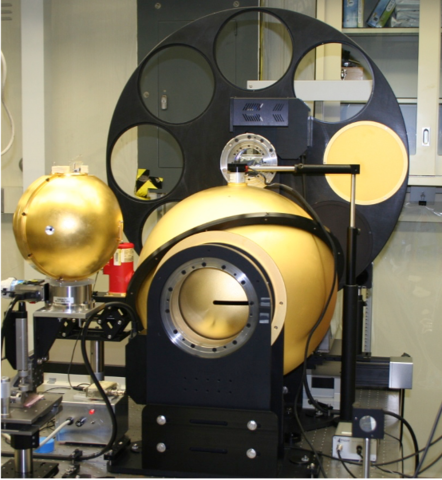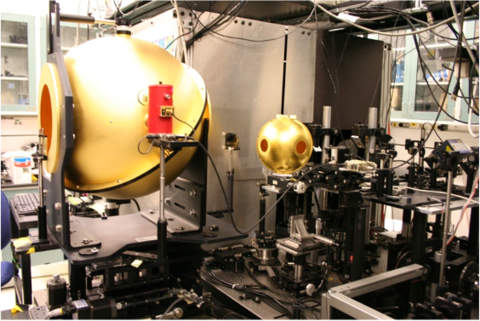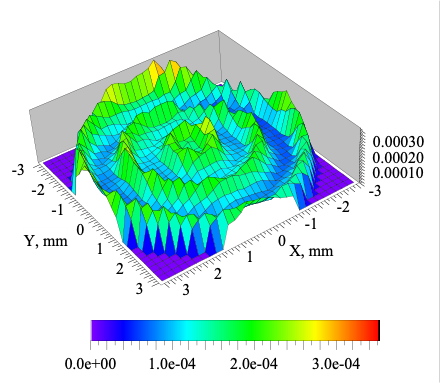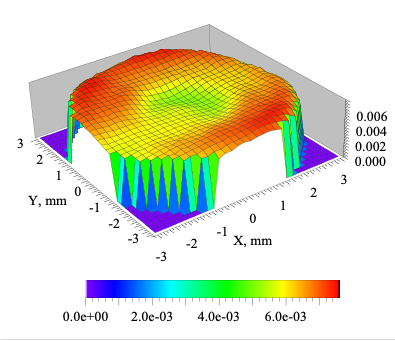Complete hemispherical infrared laser-based reflectometer (CHILR)

Photo showing a front view of the CHILR and CHILR II spheres for measuring cavity reflectance with minimized entrance port (CHILR) and slit (CHILR II) to capture the input laser beams and retain nearly all the rear mounted cavity or sample reflected light.
A custom instrument, the Complete Hemispherical infrared Laser-based Reflectometer (CHILR), employs a gold integrating sphere and is used for the measurement of the normal directional-hemispherical reflectance of samples and complex structures such as cavities used in blackbodies and radiometers. Measurements are made using light input from a selection of lasers covering the infrared spectral range from 1 micron to 11 microns, a diffuse-gold-coated integrating sphere, with a 50 mm cavity/sample port diameter, collecting the reflected and scattered light, and pyroelectric and MCT detectors.
A second, larger reflectometer (CHILR II) has recently been added to the facility providing a 200 mm diameter collection port enabling measurement of large diameter blackbody cavities that are commonly used as spectral radiance standards for infrared earth remote sensing systems. CHILR II employs the same set of laser sources and detectors as CHILR. Together, the reflectometers enable the measurement over a wide dynamic range of reflectance values as well as cavity aperture sizes..
Each reflectometer is designed to collect and measure nearly all the light that is reflected from a sample or cavity into the 2π solid angle in front of it. Because of the high power and small diameter of the collimated laser light (< 4 mm diameter), a small sphere entrance aperture or slit can be used (6 mm diameter / width) This corresponds to a minimal 1.7° full angle reflected light lost from the sample or cavity. This is in contrast to the 12.5° full angle of the infrared integrating sphere used for spectral diffuse reflectance of samples measured at the Fourier transform infrared spectrophotometry (FTIS) facility, where a large solid angle is required to collect sufficient flux for measurement.

The spatial uniformity and angular dependence of the hemispherical reflectance of cavities can also be measured for samples and cavities that have minimal amounts of reflected light into large angles. For CHILR, this is accomplished through a cavity mount that is held separate from the sphere and incorporates motorized linear and rotation stages for scanning. Alternatively, for CHILR II the input laser beam can be scanned across the full entrance port via rotation of the entrance slit.
Reflectance levels as low as ~ 1 x 10-6 can be measured using CHILR and ~ 1 x 10-5 using CHILR II.


Specifications/Capabilities
| Basic parameter | CHILR | CHILR II |
|---|---|---|
| Sphere diameter | 200 mm dia. | 500 mm dia. |
| Input port | 6 mm dia. | 10 mm x 100 mm slot |
| Collection port | 50 mm dia. | 200 mm dia. |
| Detector port | 12.5/50 mm dia. | 12.5/12/5 mm dia. |
| Coating | diffuse gold | optimized diffuse gold |
| Port fraction | 1.7% - 3% | 4% |

